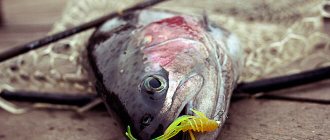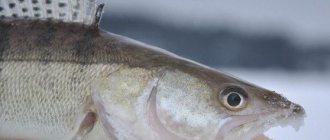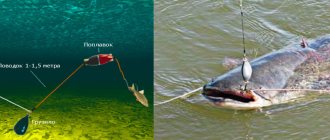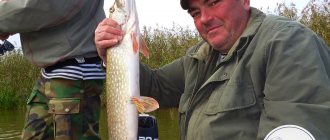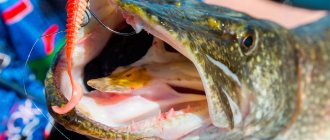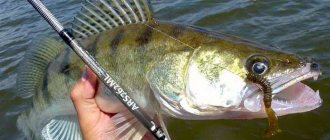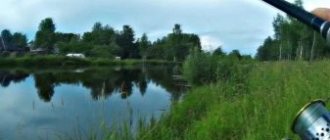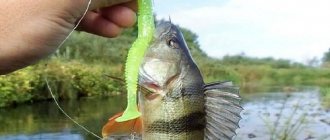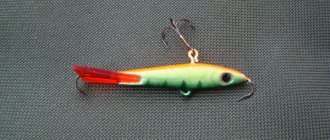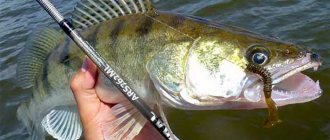With the start of the open water season, the first spinners are already right there, on the banks of their favorite bodies of water. Neither spring mud, nor slush, nor difficulties associated with traveling to specific sections of the river and approaches to treasured places stop them. But still, as they say, “hunt is worse than bondage,” and there’s nothing wrong with that
you can do it...
And so, let’s consider jig fishing immediately after the ice melts and at various stages of a light flood, when the transparency of the water either leaves much to be desired, or returns to normal. Sometimes in early spring it happens that in the upper reaches of rivers the flood has not yet begun, but in their middle or lower reaches the ice in specific sections has already been washed away or completely torn off, and at the same time the transparency of the water remains quite acceptable.
At this time, very productive and interesting jig fishing is possible, but in terms of time, the period of such fishing is short, on average about a week, plus or minus two days. In such cases, we often manage to do some good fishing before the official spawning ban dates, or we initially go to the rivers of those regions where spinning fishing from the shore is allowed. During this period, the oxygen content in the water has significantly and qualitatively improved, which, together with the increase in daylight hours, gives a biological impulse to most species of predatory and peaceful fish to leave their wintering pits and begin preparations for spawning, before which their representatives must fatten up at least a little and gain strength.
Choosing a place to fish with a jig
Since the majority of fish are generally distributed unevenly throughout the reservoir, and even more so in the spring, you must adhere to some rules in searching for the most promising points (places of their accumulation). At this time, forage fish tend to move to smaller, heated and oxygen-enriched places, where the biological activity of all living things is primarily manifested - zooplankton, insect larvae, algae, flowers and shoots of higher plants, which are the main food for leucorrhoea and its numerous juveniles.
Such places, among other things, have significantly less current than on the riverbed, and in the same flooded oxbow lakes and backwaters it is completely absent, which is especially attractive for weakened leucorrhoea after the winter period. Immediately after the linen, the predators we are interested in come here, since the linen for them, in turn, is also a food object.
If this is a backwater, a reach or an oxbow lake, then the predator should be looked for on the nearest adjacent channel edge, a gentle slope into the channel itself and on the return paths, next to which, as a rule, the bottom topography is quite rugged and it is easy for the predator to make ambushes there, waiting for a weakened or slow fish. If the backwater, arm, or oxbow are quite extensive in volume, and the average depth is from one and a half to three meters, then, regardless of the structure and type of bottom, in the spring not only pike and perch come here to hunt, but also pike perch, which, without going to deeper places , can stay here all day.
At other times of the year, this is not typical for pike perch, and it can only visit such zones at dusk and at night. In spring, you should not neglect areas that are the mouths of small rivers and sections of the lower reaches (about one third of the entire length), provided that there are no artificial barriers to the movement of fish (dams, bypass locks, etc.). ), and the total length of the river itself is at least 15–25 km.
Fish will come to these places to spawn, but begin to gravitate towards them almost immediately after the ice melts (both whitefish and the predators themselves - pike, perch, pike perch, bersh, etc.) can spawn here. Also interesting now will be the flooded coastal sand spits, ridges, “groins” and “mini-dams”, behind which a failure is formed and a significant decrease in the strength of the current, or its return occurs (preferred depths of 1.5–3.5 m).
Small fish, not being able to resist the main (rushing) stream, tend to such zones and often accumulate next to them in large numbers. Of course, these areas will attract all kinds of predators: pike perch, perch, bersh, catfish. And such as asp and ide fatten not only here, they also do not leave the riffles without their close attention. Moreover, immediately after the disappearance of the ice cover, ide is especially active on the riffles, and the chances of catching the largest individuals of this species are the most optimistic.
Pike fishing in early spring
Let's try to figure out where the fishing stories about the amazing spring glutton of pike came from, because as they say, there is no smoke without fire, and perhaps there are reasons for such a story to appear.
Let's start with spawning, every year at almost the same time, and in the same place, pike rushes to spawn.
All pike in the spring follow the same routes, repeating their many-year journey to the same spawning ground.
And practically nothing can turn persistent pikes off this path, except perhaps people with their intervention. After a little thought, it turns out that any fisherman who has found the paths of pike going to spawn can meet its good bite.
The point is that the concentration of fish in the spawning area is very high, and an abandoned bait can be encountered by several pike at the same time, one pike will let the bait pass by, the third will miss it, and the fifth will get into the mouth of this bait and the pike will grab it. And knowing that there are a lot of pikes in such a section of the reservoir, one of them will get hooked anyway.
But be reasonable and do not catch pike during the spawning period, let it continue its race.
If fishermen respect nature, the harm caused to pike will be minimal, and future generations of fishermen, just like you, will be able to feel the joy of fishing.
This is where the myths about super-biting pike in spring come from. The fisherman just happened to be in the right place and time.
And a fisherman who, a year later, comes at the same time to the same place will also be successful in fishing, since the pike does not change its spawning area throughout its life.
But still, it is better not to catch pike during spawning, since catching one fish will kill thousands of future pike. An interesting fact is that other types of fish sense the spawning of pike and go to eat pike eggs.
That is, the more eggs white fish eat, the less pike their offspring will eat in the future. That is, it turns out that white fish, by eating pike caviar, save their species.
True, the pike in the first days after spawning does not go far from the spawning site, and successfully feasts on the arriving fish, thereby saving its offspring.
After the pike has rested and eaten, it returns to its usual habitat, so that next year it will return again and give birth to another generation of pike pikes.
Take care of nature, do not catch pike during spring spawning, and nature will thank you with a rich catch in the future.
Also on the topic of pike fishing, see our previous reviews:
- Pike habitats
- Wobblers for pike
- Pike on spoons
- Catching pike with spinners
Behavioral characteristics of predators in spring
Around the same time, the pike perch’s appetite begins to show. With each sunny day, with each degree the water warms up, it will only increase in pike perch and, when it reaches 10–12 degrees, it turns into a pre-spawning glutton. It is quite obvious that, taking into account the characteristics of each region, it occurs for pike perch at different times, and much will depend on weather conditions (early or prolonged spring, wind, precipitation, etc.). For a novice spinning player, even in his own region, it is very difficult to navigate and understand when this rush began or will begin and when you need to be near the river so as not to miss it. However, there are still very clear natural criteria that help us. One of the external landmarks are the trees that we see in the floodplain of the river.
If, upon arrival at the reservoir, the floodplain is still gray in color and the buds are swollen, but do not bloom, then there is still more to come. If the buds on the branches burst and the leaf begins to peel, this is a clear sign that the pike perch’s pre-spawning appetite has begun to activate (the floodplain begins to turn green). If the floodplain is completely green (people say “blooming”), then pike perch can still be caught, but the peak of its activity is behind us.
The very peak of the pike perch bite is when black currants bloom in your region or region (for a period of no more than a week). So, if you want to be with spring pike perch, in the spring you will have to plant a garden or plant a “natural barometer” bush right at your entrance, which never fails. Pike, at the moment, is least inclined to engage in predatory behavior; it is now busy with itself and goes to spawn, after which it will still recuperate for two to three weeks.
And there is practically none in our catches, except for the “pencil” squinting animals, which must be released. But let's go back to the very beginning of spring, when the rivers just opened. In this short period of time, even the catfish leaves the pits (so far only temporarily) to make the first “exercise” in their possessions and satisfy their hunger after a long winter torpor.
He will return here, to the pits, for at least two to three weeks, and in more northern latitudes for a month. But during this first, and sometimes even the second week, he is very active and often flies into our baits, respectively, when catching the same pike perch or pike with a jig, and if possible, this turn of events must be kept in mind.
Catching pike perch in spring video
An excellent video about catching pike perch in early spring with a jig before spawning. A program from the Shcherbakov brothers from the ABC of Fishing series, which describes all the subtleties and secrets of choosing equipment, bait, spinning rod and wiring, as well as fishing techniques and tactics.
An interesting report about fishing for pike perch with a spinning rod in the spring. The video was filmed on April 19, 2016, but nevertheless has not lost its relevance. Fishing was carried out in the Staropoltava region. The fishing depth was 10-15 m. Wiring: double step from 6 to 10 meters and from 10 to 15 meters. So I recommend everyone to watch it.
Video about jig fishing for pike perch in early spring. Fishing took place in April on the Lower Volga River in the Enotaevsky district of the Astrakhan region. Well, I suggest you see what came out of this for yourself and evaluate what is happening.
Tackle for spring jig
Including for the reason stated above, spring tackle - a spinning rod, a reel and the rest of the equipment (in terms of hooks, carabiner tests, breaking loads of braided cords) - are among the most powerful and durable, which I use throughout the entire open water season. But still, and here we shouldn’t go into “gigantomania”, a 15-20 liter cord and high-quality hooks with winding rings and carabiners for extension up to 12 kg are enough, and this is only if we know that we are going to fish in snags or nearby it, where forced fishing is often the only possible option.
At the same time, we should not forget that in order to avoid damage to the spinning rod, the librage of the braid we have chosen should never exceed the numbers indicated on its form. For example, if the spinning rod is marked with a test of 8–17 pounds, in the spring it is advisable to use a thread whose breaking load is no more than 12–15 pounds.
Lures and rigs for jig fishing in spring
Of the silicone baits at this time of year, baits of contrasting colors, i.e. “acid baits,” work better and give more stable results.
(lemon, bright green, bright orange, bright yellow), you can also safely add bright white baits here. In muddy spring water they are more noticeable than neutral, natural, gray, dark tones, which are not very suitable for conditions of limited water transparency (although bites on these colors are possible, but they happen quite rarely). Their time will come later, with sufficient clearing of the water.
Since after the spring flood on fast-flowing rivers the bottom topography, its structure and the location of last year’s snags almost always change, we don’t even know at a certain point what kind of clean or snagged area we will have today. Where we previously fished with an open rig (silicone bait on a jig head, Cheburashka), now, in order to avoid unnecessary losses, it is advisable to start fishing and get acquainted with the bottom topography and baits with offset hooks.
When we break through the area and understand that it is quite clean, and weak bites (graters, touches) of fish sometimes occur, then for their more effective implementation we can and should switch to rigs with open hooks (jig heads and doubles).
Catching pike perch in early spring with a jig
As for jig fishing itself, it is just as successful in early spring as in summer or when catching pike perch in the fall. The same twisters, vibrotails and foam fish are used as jig baits. A number of fishermen use scented silicone baits, explaining this by the fact that in muddy water the bait is practically invisible. However, it should be noted that fish vision is structured somewhat differently than human vision; in addition, pike perch only occasionally uses the sense of smell when searching for food. However, no one forbids fishermen to experiment. You can also try your luck by hooking a frozen sprat onto a jig head hook.
Lures for catching pike perch are mounted both on classic jig heads and “Cheburashkas”, and on offset hooks with a bullet sinker (in places with a large number of hooks). When fishing for pike perch in the spring, a regular jig is used: after casting, the bait is placed on the bottom, then raised with two or three turns of the reel, allowed to lie on the bottom again, and the cycle is repeated again. In the absence of bites, it makes sense to increase the pause time, and in general, do not forget that in cold water pike perch is much less active than in summer.
In conclusion, I would like to remind you that in addition to the ban on the use of boats, in a number of regions, after the ice melts, spinning fishing is also prohibited. Therefore, before you go hunting for pike perch, study the Fishing Rules for your region to avoid troubles and misunderstandings. Fishing should bring only positive emotions!
Posting jig baits in spring
Retrieving most jig baits is best done with them hanging as much as possible in the water column and with as short a step as possible, i.e. one rather sharp turn of the reel handle and a pause in the fall from two to five seconds (this effect can only be achieved by retrieving against the current) . Across the current and in stagnant bodies of water, it is better to do the opposite - at the slowest possible pace, rotate the reel handle from three to five turns, so that the jig bait seems to slide above the bottom, and a pause is made only in order to control (not lose) the bottom.
The movement of the jig bait should not be fast now, the fish is weakened, and it has neither the strength nor the opportunity to chase the fast bait due to limited visibility (the transparency of the water is not changing for the better). If, after reeling in the reel, the pause in the fall of the jig bait is too long (more than 1 second), then this indicates that the bait is going too high from the bottom and the rotation of the reel handle needs to be made even slower. If there is practically no pause, then the rotation of the reel needs to be accelerated a little or this can be achieved by reducing the mass of the eared sinker on the bait.
Shore fishing with a retractable leash (using silicone flowers, mentioned above) also gives good results in the early spring. Further, depending on weather conditions, after the first 7–10 days (and sometimes two weeks), with the water warming up by only 3–4 degrees, a predator such as pike perch becomes more active and, with sufficient water transparency, already responds very well to standard jig wiring. Here the size of the bait depends on the fishing conditions and the type of reservoir, but if these are lakes or reservoirs, where the transparency of the water is always quite stable, then also on their colors.
It is also very useful to know what main type of fish the predator currently feeds on and what is currently in its diet. It can be a goby, roach, ruffe, nosy ruffe, perch and of quite different sizes. Therefore, it is not superfluous to check the stomach contents of the first 2-3 fish caught; this approach helps to very quickly decide on the choice of silicone baits, both in color and in size (especially in unfamiliar bodies of water). The same technique will work after the spring ban.
My best silicone lures for jigging in spring
In the spring, the most in demand in my arsenal for jig fishing from silicone baits (plus foam rubber) are:
Shaker by Lunker City
Shaker from Lunker City 3.25 and 4.5 inches (photo 1). Works great on bodies of water with current (priorities in descending order: pike perch, pike, perch, asp, ide). Favorite colors 01, 06, 059, 72.
Awaruna by Pontoon 21
Awaruna from Pontoon 21 (photo 2). These vibrating tails showed excellent performance both in the current and in standing bodies of water (lakes, ponds, stakes, oxbow lakes, quarries, etc.). I caught the lion's share of the time with these baits in sizes 3 and 4 inches. The pike perch is simply not indifferent to them. If I know that there is still a pike perch on the point, but it is passive and needs to be stirred up - to swing the point, then this bait is one of the best. Almost all colors work. There wasn't a color that I couldn't catch. Everyone works great. Spring favorites for muddy water are colors 102, 410, 420 and 402; with clearing of the water, color 201 gave the best results. In summer, colors 105, 201, 202, 204 and 409 were more in demand. In the fall, the leaders were definitely 404, 405, 406 and 423.
Skippy Fish
Skippy Fish 4-inch (photo 3). Excellent spring results when fishing with a spinning rod on drains, as well as when the water gets colder, and on different types of reservoirs. Both pike perch and pike are equally not indifferent.
Wooly Hawgtail by YUM
Wooly Hawgtail from YUM, colors 17 and 28, size 3 inches (photo 4). This is my best silicone bait for still waters and moderate currents, at any time of the year. 4.5 inches in green colors for three seasons in a row give excellent results in the fall, just on medium rivers with a decent current, both for good zander (3-4 kg) and for pike. I hope next season will be no exception.
Walleye Grub
Walleye Grub size No. 3 and No. 4 (photo 5), color 354 (popularly “schisandra-acidic”) is one of the most popular and consistently produces results in early spring over the last 6-7 seasons, when water transparency left much to be desired. This is her time.
Twister worms
Twister worms in photo 6 (but you can try both wecks and slugs) are silicone baits that have a flat tail with a large or small bend. The bend can be like a twister, or it can be only slightly noticeable or longer, but always flat, so that even with uniform slow wiring, the tail of the worm is mobile and makes oscillatory movements. Many manufacturers have such worms. But YUM, Action Plastics, Gary Yamamoto, Mister Twister took root in my box.
The wiring technique for silicone worms is very diverse (an explanation requires a separate topic). All this is done at the level of intuition, sometimes the animation technique arises spontaneously (since a lot depends on the place of fishing, depth, current, wind, clean bottom or snag). This includes playing with the tip of the spinning rod during a slow monotonous retrieve, and throwing the worm down the edge only by moving the spinning rod blank. It is also appropriate to throw a silicone bait sharply against the current with a spinning rod blank, followed by giving the blank back until the bait touches the bottom, as well as simply dragging the worm along the bottom while simultaneously playing with the tip of the spinning rod.
Casting across the current, followed by a slight lifting of the silicone bait from the bottom with a spinning rod, with further monotonous rotation of the reel about 3-5 turns of the handle, also works. In this case, the tip of the spinning rod vibrates with a small amplitude and a fairly high frequency; you can diversify the same wiring by pulling along the bottom. However, for silicone worms, ordinary jig wiring is quite applicable, the main thing is to know that worms catch and sometimes catch in the spring much better than any other silicone bait.
Sawamura One Up Shad
Sawamura One Up Shad (Japan, photo 7 right row) This silicone bait is impregnated with all kinds of attractants and salts that remind the predator of the taste qualities of its prey, which helps to keep the bait in its mouth for a longer time. In order to be able to make a high-quality hook when a fish bites, this silicone bait has special slots for an offset hook (it comes out of the body very freely), making it more convenient during installation, plus increasing the non-clinging and passability of the bait on snags and other debris, located at the bottom.
Also, this silicone bait Sawamura One Up Shad is very soft and allows you to fish in bodies of water where there is no current, because with the slowest retrieve, the “penny of the tail” of the bait comes to life, producing oscillatory movements, which allows you to make high-quality retrieve at minimum speed. Moreover, the smell of the bait itself is very similar to the smell of freshly caught fish (this is how our hands often smell after catching it), which in turn is also an additional irritant for predatory fish, provoking it to attack (grab) our bait. Gambler The EZ Swimmer (USA manufacturer, photo 7 left row). Also “edible”, it’s practically an analogue, a clone of the rubber described above, but the bait itself is a little rougher in composition and has a pronounced garlic smell, which is one of my favorites when fishing for pike perch.
Fox Rage Chatter Tail
Fox Rage Chatter Tail, size 3.9 inches (photo 8). Due to its ultra-soft silicone composition, it is an excellent option for fishing in low-flowing and standing waters. The manufacturer took very detailed and thoughtful care in installing the offset hooks; to be honest, I have never seen anything like this in silicone baits before.
XZone Swimmer
XZone Swimmer 3.25; 4 and 5.5 inches (photos 9 and 10). The silicone composition is more dense, but due to the structure and area of the nickel, the tail of the bait is very mobile. Excellent for fishing in any body of water. It mounts perfectly, whether on jig heads or offset hooks. When mounted on an offset with an extended “Z” (zet) forend, it becomes generally difficult to kill.
Foam rubber
Foam rubber (photo 11). Favorite size 7–8 cm. Works always and at any time of the year. Often it allows you to get away from zero when all the silicone is “silent”. In versions equipped with an offset or double with hooks pressed to the body, it is an excellent scout bait when fishing in unfamiliar places and snags. If the situation requires it, foam rubber allows you to make the farthest casts of all types of bait and quickly search for active fish over maximum areas. It works well with all kinds of attractants, the parallel use of which (after slightly warming up the water) increases the overall fishing efficiency. I use dark foam on a sandy bottom, and light foam on all other types of bottom.
Epilogue
Try, search, experiment, and the result will not keep you waiting. Just a minute ago you didn’t know whether you were doing the wiring correctly, whether it was the right bait on the hook or whether you needed a different one, but finally the long-awaited bite happens, followed by a difficult struggle and - the trophy is already tap-dancing on the shore... In fact, this is what lies the beauty of fishing.
Alexander Afanasenko
Silicone lures for pike
When it comes to catching pike with jigs, the best silicone baits are vibrotails and twisters. Fishermen note that pike bite best on silicone the color of machine oil, although the colors can be completely different in different bodies of water.
